H&M has blamed the pause and eventual winding-down of its Russian business for a significant drop in revenues and profits.

For the third quarter ending August 31, fashion giant H&M reported a one-time cost of SEK 2,104m related to the winding-down of its Russian operations.
However, the fashion giant was also not immune to wider macro-economic headwinds, including surging prices for raw materials and a strengthening US dollar driving up buying costs.
Operating profits for the period more than halved to SEK 3,006m (£245.8m) – down from SEK 6,272m (£512.9m) –with an operating margin of 5.2% compared with 11.3% year on year.
The group’s profit after tax, excluding Russia costs, was SEK 2,151m (£175.92m) – down from SEK 4,692m (£383.7m).
Nine-month numbers for the Swedish fashion giant are better, with H&M Group’s net sales in SEK increasing by 13% in the first nine months of the financial year to SEK 161,120m (£13,177m) and 8% in local currencies.
Operating profit excluding the one-time cost for Russia was SEK 8,099m (£662.3m) – down from SEK 8,996m (£735.m) and the operating margin was 5% down from 6.3%.
Chief executive Helena Helmersson said: “The third quarter has largely been impacted by our decision to pause sales and then wind down the business in Russia. This has had a significant effect on our sales and profitability, which explains half of the decrease in profits compared with the third quarter last year.
“Many other external challenges also made their mark on the quarter. In common with the rest of the industry, sales were weak in many of our major markets at the start of the period. Sales then gradually improved, despite a heatwave in several European countries and some remaining delays in the supply of goods.
“Increased raw materials and freight prices, as well as a stronger US dollar, resulted in substantial cost increases for purchases of goods. We have chosen not to fully compensate for the increased costs, which is reflected in the gross margin. Overall, these factors had a substantial negative impact on profit for the quarter.
“Long-term initiatives to meet customers’ ever-increasing expectations are continuing. This involves ensuring the best customer offering for all the brands and the best customer experience. In a situation of high inflation where household living costs are rising significantly, it is more important than ever to offer customers the best value for money.
“Sales channels are being increasingly integrated, alongside continued digitalisation of the supply chain. Efficiency, speed and flexibility have never been more important. In parallel, a programme to reduce costs and further improve efficiency is being initiated. From the second half of 2023 onwards, this is expected to result in annual savings of around SEK 2bn.
“With loyal customers all over the world, engaged colleagues and sound finances, in combination with a long-term perspective, we see good opportunities to strengthen our position despite the situation in the world around us.
“The autumn collections have been well received and sales in September are up on the previous year, providing important proof that the H&M group is growing even when customers’ purchasing power is decreasing.”
- Get the latest fashion news and analysis straight to your inbox – sign up for our weekly newsletter
























No comments yet